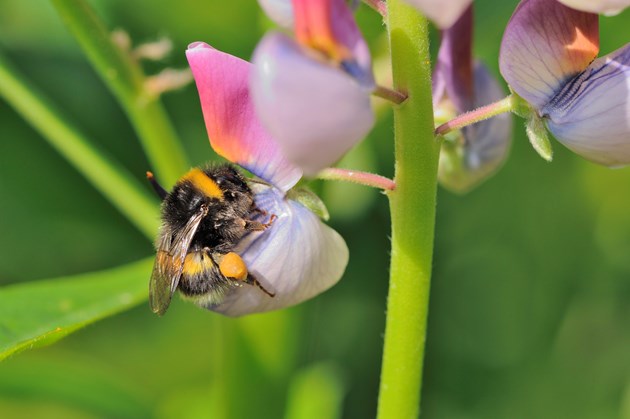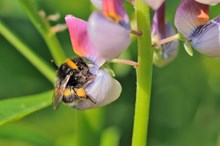10 March, 2023
Scotland is buzzing with pollinator-friendly activity

A wealth of projects to help pollinators are taking place across Scotland to tackle biodiversity loss and the nature crisis, a new NatureScot report reveals.
The Pollinator Strategy 2022 Progress Report highlights the work of organisations coming together across the country to create wildflower meadows, connect habitats, and gather evidence on how climate change is affecting pollinators.
This fifth report on the wide range of projects helping to deliver The Pollinator Strategy for Scotland details the progress made by a range of environmental bodies, local authorities, scientific colleagues and community groups through to individuals in order to make Scotland a place where pollinators thrive.
Pollinator-friendly practices have been on the increase around housing and golf courses, with impactful projects such as the Irvine to Girvan Nectar Network establishing a Scottish Wildlife Trust-led partnership. The project builds connected habitat networks for wild pollinators and increases the resilience of local pollinator populations. Twelve new meadows have been created, and sites supported and enhanced included Eglinton Country Park, areas around Royal Troon Golf Club course and 2ha of public greenspace. The project saw trials of green hay to make large meadows, the launch of the Ayrshire Wild Apple Tree Pollinator Project and the sowing of kidney vetch at seven sites - building upon the existing Small Blue Butterfly Project. All the new meadow managers have committed to care for them into the future.
Pollinators Along the Tweed is an ambitious project which aims to create, restore and enhance up to 40 hectares of wildflower-rich habitat across 50 sites over five years. It is led by a group of funders including NatureScot.
The past year also saw a commitment from Stirling Council to consult on a local pollinator action plan – following similar ambitions from Aberdeen, Falkirk and Glasgow councils. The council has a target of managing 50% of its open space for biodiversity. As Scotland races to halt biodiversity loss by 2030, such projects will be crucial to help pollinators thrive by reducing areas of intensively managed grass.
In a year which enjoyed a return to a near-normal season of field work, following the pandemic, the Pollinator Monitoring Research Partnership gathered valuable data from both 1km square surveys and Flower-Insect-Timed Count (FIT-Count) exercises. The new app, to enable FIT-Count reporting to be carried out digitally, proved extremely popular as was the presence of a revamped UK Pollinator Monitoring Scheme website. The importance of gathering evidence of change in populations of pollinating insects is vital to Scotland’s ambition to halt biodiversity loss by 2030 and restore nature by 2045, and will be the focus of this year’s Scottish Pollinators Conference on 15 June.
NatureScot Pollinator Strategy Manager, Jim Jeffrey said “Collaboration lies at the heart of the Pollinator Strategy for Scotland. We are fortunate that across Scotland a range of inspirational partners continue to help achieve a better environment for pollinators.
“Projects such as the ambitious Irvine to Girvan Nectar Network and Glasgow Pollinator Plan show an increasing emphasis on creating and managing habitat for pollinators. This year our annual pollinator conference will focus on monitoring, drawing on the expertise of speakers from across the UK and beyond, and our hope is that this will encourage even more people to engage in work to help pollinators under Scotland’s Pollinator Strategy.”
Read the full Pollinator Strategy 2022 Progress Report.
For tips for how to help pollinators at home see NatureScot’s Make Space For Nature campaign, and follow the Scottish Pollinators blog for updates on projects across Scotland.
ENDS
Contact information
- Name
- NatureScot Media
- Telephone
- 0131 316 2655
- media@nature.scot
NatureScot is Scotland's nature agency. We work to enhance our natural environment in Scotland and inspire everyone to care more about it. Our priority is a nature-rich future for Scotland and an effective response to the climate emergency. For more information, visit our website at www.nature.scot or follow us on X at https://x.com/NatureScot
’S e NatureScot buidheann nàdair na h-Alba. Bidh sinn a’ neartachadh àrainneachd na h-Alba agus a’ brosnachadh dhaoine gu barrachd suim a chur ann an nàdar. Tha e mar phrìomhachas againn gum bi nàdar na h-Alba beairteach agus gun dèilig sinn gu h-èifeachdach le èiginn na gnàth-shìde. Tha an tuilleadh fiosrachaidh aig www.nature.scot no air X aig https://x.com/NatureScot

